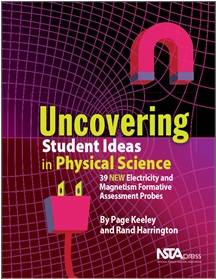But Why Does the Balloon Stick to the Wall After I Rub It on My Hair?
By Carole Hayward
Posted on 2014-06-24
 What types of materials can be electrically charged? How does current flow in a circuit? Will a magnet pick up any kind of metal? In answering these types of questions, children will reveal their own preconceptions about ideas that they bring with them into the learning environment. Their teachers need ways to help them identify misunderstandings that may occur during instruction. That’s why probes are an essential component in the science teacher’s toolkit.
What types of materials can be electrically charged? How does current flow in a circuit? Will a magnet pick up any kind of metal? In answering these types of questions, children will reveal their own preconceptions about ideas that they bring with them into the learning environment. Their teachers need ways to help them identify misunderstandings that may occur during instruction. That’s why probes are an essential component in the science teacher’s toolkit.
Page Keeley and Rand Harrington, in their book, 39 NEW Electricity and Magnetism Formative Assessment Probes (Vol. 2 in the Uncovering Student Ideas in Physical Science series), bring K-12 teachers a whole new collection of carefully researched and developed probes around electric or magnetic phenomena or concepts.
Designed to be used as formative, rather than summative assessments, these intellectually engaging probes are designed to “stimulate student thinking and involve students in productive discussions as they grapple with their own ideas and consider the ideas of others.” The feedback gleaned from each question provides non-judgmental, valuable feedback to both educators and students in grades 3-12.
The book organizes 39 probes into three sections: Electric Charge; Electric Current; and Magnets and Electromagnetism—with each section starting off with a concept matrix identifying the main concepts related to the probe and the suggested grade level for each. Related ideas from the 2009 updated version of the Benchmarks for Science Literacy and links to the Next Generation Science Standards are included as well as related NSTA resources, such as books, journal articles, and collections from NSTA’s Learning Center.
Teachers will appreciate that each probe starts off with a question and a series of responses from which students can choose—with the related expectation that students will explain their thinking on the answer they selected (such as what rule or reasoning did they use in making their predication). Each probe is accompanied by teacher background notes—critical components for educators to explore/examine prior to using each probe—that cover the following areas:
- Purpose: What is the idea that the probe intends to uncover/reveal? Does the probe fit your learning target? This section helps you answer these critical questions.
- Related Concepts: Each probe is designed to target one or more concepts (defined as a “one-, two-, or three-word mental construct used to organize the related ideas addressed by the probe and the related national standards).
- Explanation: This section offers a brief scientific explanation and clarification of the scientific content that underlies the probe.
- Administering the Probe: Importance guidance is provided for administering the probe to students and covers areas such as suggested grade levels, ways to demonstrate the probe scenario, and modifications (to adapt to different learners).
- Related Research: Each probe is informed by research.
- Suggestions for Instruction and Assessment: Need a brief suggestion to help you plan or modify your curriculum and instruction so that you can help your students who are struggling with difficult or misunderstood ideas? This section will help you do that.
- Safety: This section provides suggestions created by NSTA’s science safety consultant for practicing safe science in your classroom—a must read!
- References: References are provided for the standards, research summaries and several of the instructional suggestions provided in the teacher notes.
Keeley and Harrington, in their introduction, acknowledge that “we are surrounded daily by the phenomenon produced by electric charge—these charges are what makes things work, including all the electronic devices we own.… Yet most of us have only a vague notion of what electric charge is and even less of an understanding of where these charges come from, where they go and how they move around.”
Happy Uncovering in this easy-to-read (you don’t need to be a science specialist to understand the contents!) resource!
This book is also available as an e-book.
Learn more about other books in the Uncovering Student Ideas series.
Disclaimer: The views expressed in this blog post are those of the author(s) and do not necessarily reflect the official position of the National Science Teaching Association (NSTA).


